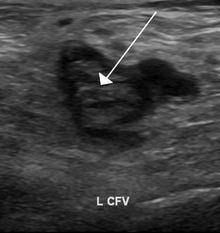| Thrombophilia | |
|---|---|
 | |
| An ultrasound image demonstrating a blood clot in the left common femoral vein. | |
| Specialty | Hematology |
Thrombophilia (sometimes called hypercoagulability or a prothrombotic state) is an abnormality of blood coagulation that increases the risk of thrombosis (blood clots in blood vessels).[1][2] Such abnormalities can be identified in 50% of people who have an episode of thrombosis (such as deep vein thrombosis in the leg) that was not provoked by other causes.[3] A significant proportion of the population has a detectable thrombophilic abnormality, but most of these develop thrombosis only in the presence of an additional risk factor.[2]
There is no specific treatment for most thrombophilias, but recurrent episodes of thrombosis may be an indication for long-term preventive anticoagulation.[2] The first major form of thrombophilia to be identified by medical science, antithrombin deficiency, was identified in 1965, while the most common abnormalities (including factor V Leiden) were described in the 1990s.[4][5]
- ^ Cite error: The named reference
Kumar4was invoked but never defined (see the help page). - ^ a b c Cite error: The named reference
Heitwas invoked but never defined (see the help page). - ^ Cite error: The named reference
Kyrle10was invoked but never defined (see the help page). - ^ Cite error: The named reference
Dahlbackwas invoked but never defined (see the help page). - ^ Cite error: The named reference
RosendaalReitsmawas invoked but never defined (see the help page).